Why Nintendo chose DMP’s PICA200 GPU for the 3DS – technical details and insight
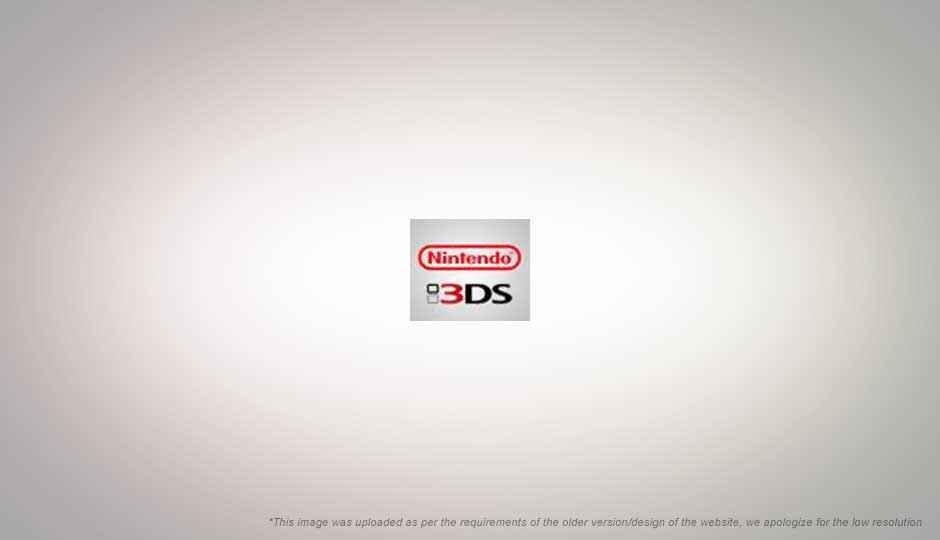
So, we have got ourselves a winner… the Nintendo 3DS will be the first handheld gaming platform to provide a full stereoscopic 3D gaming experience without any need of those pesky 3D glasses. Let’s face it, nobody likes to wear those clown looking goggles, but we have to, because in order to experience stereoscopic 3D (s3D from now on…) with the technology that is mainly available for consumers (passive filtering of s3D), spectators are compelled to adopt some form or the other 3D image splitting for either eyes.
 Survey
SurveyThat is where Nintendo came to the rescue. The all new Nintendo 3DS has a revolutionary new technology that will produce complete s3D for the user with the help of a new graphics IP core from Digital Media Professionals (DMP), named PICA200, and a display screen that can produce two different images of a scene for stereoscopic vision.
Technical Specification
| Nintendo 3DS Specification | PICA200 tech-spec | DMP MAESTRO features |
|---|---|---|
|
|
|
Insight of the graphics IP core and Maestro API
Being showcased first in SIGGRAPH 2006, the IP core of PICA200 was developed by DMP with three things in mind:
- The IP core must support a wide colour gamut to support all embedded system displays (from tiny mobile phone to the large amusement console displays)
- 3D graphics hardware must have huge bandwidth for command, texture, color and z-buffer read/write access (as this bandwidth determines the performance of 3D IP core), and
- IP core should be easy to integrate in an SoC system environment.
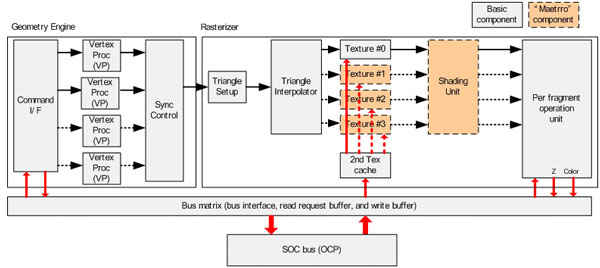
These were the primary reason for going Open Chip Protocol (OCP 2.2) specification for the development process. The biggest advantage of using OCP is to utilize the core optimization (for better Maestro performance regarding the device needs), resource pre-fetching, better memory access etc. and being an open standard, OCP also provides good understandability for both IP provider and x manufacturer.
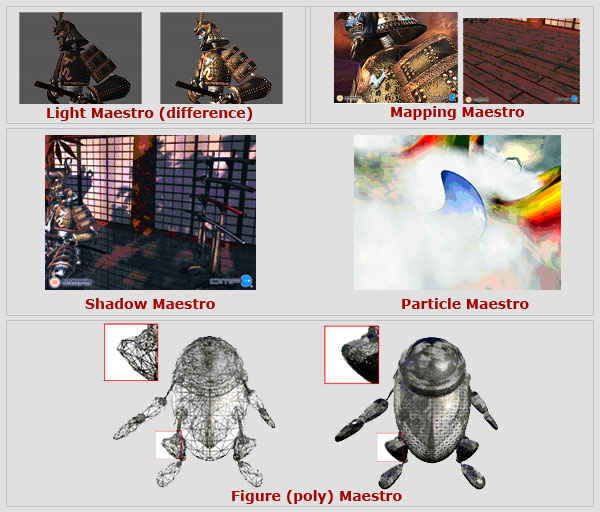
The key factor towards attaining this performance level as well as being energy efficient is the Maestro graphics API, which is able to juice out every single drop of OpenGL ES 1.1. It provides the developers with a library of massively used and nice looking elements/functions (for example – shaders, light elements, even shape primitives) for them to use directly to create rich graphics, thereby reducing the need of writing/scripting these elements. Check out the images to understand the features of Lighting, Shadow, Figure, Mapping and Particle Maestro.
Autostereoscopy and Nintendo 3DS
The technique of displaying in 3D using solely the screen, without any special aid of bi-chromatic goggles, is called ‘autostereoscopy‘. In Nintendo 3DS, the ‘autostereoscopy’ achieved with a specially designed screen, which has a multi-parallax barrier layer that effectively projects two different images of the same object to each eye, to create the illusion of binocular vision. Having a resolution of 800×240 pixels, where each alternative pixel column produces image to either left or right eye, the screen is effectively comparative to a 400×240 pixel display per eye. As the angle of the light emission is fixed at a certain time, so there will be a ‘sweet spot‘ of viewing from where the perception of 3D is tasted at its best.
Though it may seem delighting at first, staying within the sweet spot may start annoying the user, forcing him/her to keep a constant distant from the screen to view the 3D effect at its best. As the developers report, the sweet spot distance is one and half to two feet away from your eyes. So if you hold it from a distance or just right at your face, the fun is gone. And also remember not to hold the device askew of your vision line, for that may cause fuzzy screen or doubled-overlapped images.
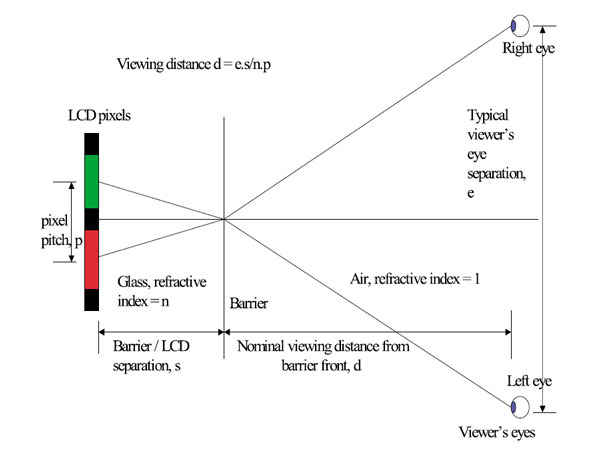
Apart from this caveat, the device manages to deliver 3D quite efficiently. The 3D depth slider on the 3DS is used to manage the desired depth of 3D perception. It can even be used to turn the 3D off, making the screen technically a 2D display.
Along with 3D output, we should also mention the ability of the Nintendo 3DS to capture 3D still images and video with the help of the two stereo camera system behind the display screen. Although being just VGA cameras, this device may give novices the option to shoot in 3D.
Performance
The first prototype, showcased at E3 2010, was able to produce a frame rate of 60-fps while playing the Mario Kart. When the developers were interviewed, they showed no interest in increasing the fps; as the display operates at a frequency of 60Hz , there’s no point making the GPU struggle for more fps, as it would be literally a waste of resources. Nintendo, instead, wants to go deep into the quality of the graphical output and smoother operation.

From the technical specification we see, the PICA200 GPU can render upto 15.3 million polygons per second and 800 million pixels per second at its stock build of 200MHz operating frequency. But the rumour says that the PICA200, crammed inside of Nintendo 3DS, will be clocked at 400MHz – increasing the performance significantly.
Although it sounds eccentric, Nintendo plans to cut off any such extra graphical capability that it neither needed nor intended. That was the sole purpose of rejecting Tegra, which, if compared, can perform multiple times better than DMP’s PICA200, but is not on par with power vs. performance vs. price ratio. That’s why the 3DS prototype exhibited eight to ten hours of gameplay at full charge with PICA200.
Selection of the Graphics Core
Rigorous contemplation was carried out over the semiconductor and IP products since 2006, from suppliers such as ATi (partner for Wii GPU), ARM (DS GPU provider), Imagination Technologies, Nvidia, and others. The selection of the 3DS’ (with autostereoscopy in nascent stages) graphics processing unit wasn’t easy. The final decision to use DMP’s PICA200 design was made over a year ago and testing and development have been going on for some time.
Nintendo, being the most reliable game console manufacturer, integrates the most optimized hardwares on their devices, thus keeping the developers and gamers both happy at the same time. So, when it comes to the choice of the perfect graphics core, it was never an easy step to take, where the balance of the parameters, such as raw die cost, power consumption, performance and game development API support have to come to a perfect balance. Now you can understand, what took them this long to finalize PICA200.
Triumph over Tegra
Before DMP was confirmed as the graphics chip provider for 3DS, a huge rumour was in the air that Nvidia Tegra was to be used for the cutting edge performance. Being a more recent development, Nvidia Tegra really brings the best, and what is needed for gaming in mobility. But like always, Nintendo is a little less enthusiastic about the cutting edge technology, favouring more a more economically affordable solution that will manage to satisfy gamers. Moreover, being a complete system on a chip (SoC), the Tegra would diminish the flexibility of choosing different CPU chip of choice; Nintendo preferred to keep the options open (and the choice of CPU is still under consideration).
Let’s we take a brief comparison with previous version of Tegra, and see how PICA200 stands against it. Having an ARM11 MP Core running at a whooping 750MHz, the Tegra can deliver unbelievable computing capability to a handheld device. As the CPU chip is not yet confirmed for 3DS, we can’t directly compare the raw computing power, but the HDMI support, full HD video encode/decoding ability sure counts. On the graphics front, the PICA200 only supports OpenGL ES 1.1 and programmable vertex shader where even the previous generation Tegra chips supported OpenGL ES 2.0 and featured complete support for pixel, vertex and light programmability. Caveat is, Tegra’s fill rate lags behind DMP PICA200. Blessed with second generation Maestro technology, PICA200 can give out some stunning texture, lighting, shadow and anamorphic object (such as water, smoke) rendering that is truly remarkable for such an economy class graphics IP core. For the rest of the features of the Tegra, such as 12MP camera sensor support or dual HD display support; well, Nintendo doesn’t need all that on the 3DS, are are more than satisfied with the 0.3MP camera on the 3DS.
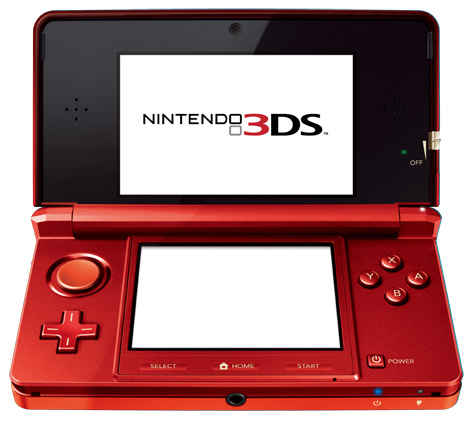
Nintendo explained how Tegra, although the finest hardware available currently, is a little too costly to get sandwiched inside a 3DS, which in turn will make the device costlier altogether. Having no intention to lose the huge market share, Nintendo refrained to hike the price of 3DS, so that it could reach as many customers as it can get. That decision effectively nullified Tegra’s chance, and thus, been-around-for-sometime DMP’s PICA200 won the battle for being cost effective as well as a steady performer.
Bottom Line
Where experience, market share, business strategy and profit are all concerned, Nintendo is way ahead of any other console manufacturer worldwide. So far we have seen that decisions taken by them are subjected to criticism at first, but then even the critics tend to follow their way (don’t forget Sony‘s comment on the Nintendo Wii-mote, and then after a few year they released PlayStation Move!). With this in hand, let’s expect that the era of handheld 3D gaming which is going to start with Nintendo 3DS, may come with the most optimally performing and entertaining package, bundled from the best hardware available.